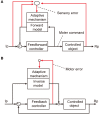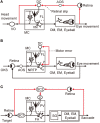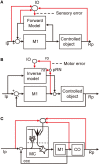Error detection and representation in the olivo-cerebellar system
- PMID: 23440175
- PMCID: PMC3579189
- DOI: 10.3389/fncir.2013.00001
Error detection and representation in the olivo-cerebellar system
Abstract
Complex spikes generated in a cerebellar Purkinje cell via a climbing fiber have been assumed to encode errors in the performance of neuronal circuits involving Purkinje cells. To reexamine this notion in this review, I analyzed structures of motor control systems involving the cerebellum. A dichotomy was found between the two types of error: sensory and motor errors play roles in the feedforward and feedback control conditions, respectively. To substantiate this dichotomy, here in this article I reviewed recent data on neuronal connections and signal contents of climbing fibers in the vestibuloocular reflex (VOR), optokinetic eye movement response, saccade, hand reaching, cursor tracking, as well as some other cases of motor control. In our studies, various sources of sensory and motor errors were located in the neuronal pathways leading to the inferior olive. We noted that during the course of evolution, control system structures involving the cerebellum changed rather radically from the prototype seen in the flocculonodular lobe and vermis to that applicable to the cerebellar hemisphere. Nevertheless, the dichotomy between sensory and motor errors is maintained.
Keywords: adaptation; error; internal model; microcomplex; motor learning.
Figures





Similar articles
-
Inferior olive and oculomotor system.Prog Brain Res. 2006;151:269-91. doi: 10.1016/S0079-6123(05)51009-4. Prog Brain Res. 2006. PMID: 16221592
-
The cerebellum and VOR/OKR learning models.Trends Neurosci. 1992 Nov;15(11):445-53. doi: 10.1016/0166-2236(92)90008-v. Trends Neurosci. 1992. PMID: 1281352 Review.
-
Computation of inverse functions in a model of cerebellar and reflex pathways allows to control a mobile mechanical segment.Neuroscience. 2005;133(1):29-49. doi: 10.1016/j.neuroscience.2004.09.048. Epub 2005 Apr 22. Neuroscience. 2005. PMID: 15893629
-
Microcircuitry and function of the inferior olive.Trends Neurosci. 1998 Sep;21(9):391-400. doi: 10.1016/s0166-2236(98)01310-1. Trends Neurosci. 1998. PMID: 9735947 Review.
-
Characterization of Purkinje cells in the goldfish cerebellum during eye movement and adaptive modification of the vestibulo-ocular reflex.Prog Brain Res. 1997;114:359-81. doi: 10.1016/s0079-6123(08)63375-0. Prog Brain Res. 1997. PMID: 9193155
Cited by
-
Comparing the Representation of a Simple Visual Stimulus across the Cerebellar Network.eNeuro. 2024 Jul 17;11(7):ENEURO.0023-24.2024. doi: 10.1523/ENEURO.0023-24.2024. Print 2024 Jul. eNeuro. 2024. PMID: 38960706 Free PMC article.
-
Lessons learned from the syndrome of oculopalatal tremor.J Comput Neurosci. 2021 Aug;49(3):309-318. doi: 10.1007/s10827-020-00757-2. Epub 2020 Jul 18. J Comput Neurosci. 2021. PMID: 32683665 Review.
-
Prominent Changes in Cerebro-Cerebellar Functional Connectivity During Continuous Cognitive Processing.Front Cell Neurosci. 2018 Oct 1;12:331. doi: 10.3389/fncel.2018.00331. eCollection 2018. Front Cell Neurosci. 2018. PMID: 30327590 Free PMC article.
-
Intrauterine and Postnatal Exposure to High Levels of Fluoride Is Associated with Motor Impairments, Oxidative Stress, and Morphological Damage in the Cerebellum of Offspring Rats.Int J Mol Sci. 2022 Aug 2;23(15):8556. doi: 10.3390/ijms23158556. Int J Mol Sci. 2022. PMID: 35955690 Free PMC article.
-
Computational Principles of Supervised Learning in the Cerebellum.Annu Rev Neurosci. 2018 Jul 8;41:233-253. doi: 10.1146/annurev-neuro-080317-061948. Annu Rev Neurosci. 2018. PMID: 29986160 Free PMC article. Review.
References
-
- D'Angelo E., Rossi P., Armano S., Taglietti V. (1999). Evidence for NMDA and mGlu receptordependent long-term potentiation of mossy fiber-granule cell transmission in rat cerebellum. J. Neurophysiol. 81, 277–287 - PubMed
Publication types
MeSH terms
LinkOut - more resources
Full Text Sources
Other Literature Sources

